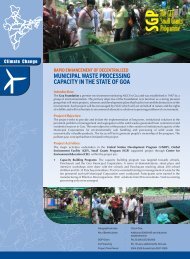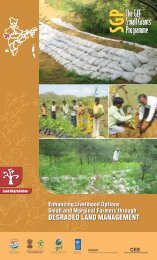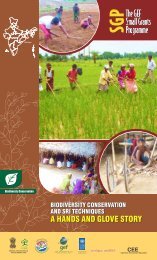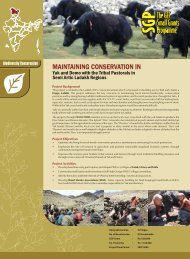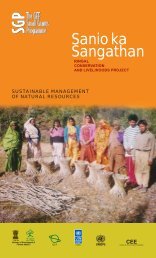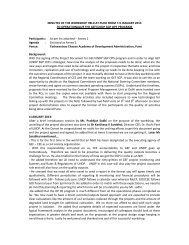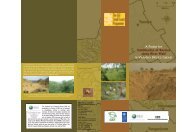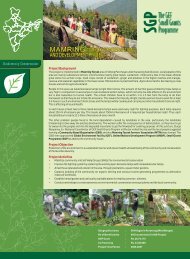COUNTRY INDIA
Country Programme Landscape Strategy - SGP India
Country Programme Landscape Strategy - SGP India
You also want an ePaper? Increase the reach of your titles
YUMPU automatically turns print PDFs into web optimized ePapers that Google loves.
Each mountain is unique in itself with respect to amount of precipitation, temperature and<br />
climate. Towards higher reaches, the air is thin and radiation is intense as ultraviolet radiation is<br />
not filtered by the thin air. The temperature varies greatly from place to place with maximum<br />
temperature in 2010 reaching up to 41.2°C during summer (May-June) in Dehradun, and<br />
minimum falling to -2.3°C during winter (Jan-Feb.) in Mukteshwar and surrounding regions.<br />
Summers are extremely hot in the valleys and pool frosts are common during winter. Generally,<br />
the winters are severe and the summers pleasant. Broadly, four seasons can be recognized;<br />
namely winter from November to March, summer from April to mid-June, monsoon from July to<br />
mid-September, and autumn from mid-September to October/November.<br />
Drainage<br />
Himalayas are the youngest; tectonically active and structurally a very complicated mountain<br />
range, from where a number of perennial rivers originate that provide sustenance to vast masses<br />
of people in the valleys and rich alluvial plains of the country. A number of important rivers like<br />
Ganges, Yamuna, Kali (Sarda), Dhauli, Gori, Ramganga (Eastern), Alaknanda, Bhagirathi and<br />
Tons etc. arise from its axis. The major rivers have their catchment separated by secondary<br />
mountain ranges arising from the main Himalayan axis and flow mainly North-East to South-<br />
West. Tributaries of the main rivers have their catchments separated by secondary mountain<br />
ranges arising from main rivers with their source in these secondary ranges.<br />
The forest cover on these hill ranges is instrumental in regulating the extent of precipitation in<br />
the region and also the flow of water in its streams. This mountain system has a dominant<br />
influence on the water regime, temperature, humidity and ecological balance of northern India.<br />
Snow or rain on its slopes feeds a number of perennial streams and rivers that flow down to<br />
plains below. With limited options exercised at the local levels as a priority in water harvesting<br />
most of the water is lost through perennial river flows.<br />
Land Use Pattern<br />
Most of the area is under forests and wastelands thus leaving behind only a small amount of land<br />
(about 12 percent) for cultivation. As of 2009-10 the net sown area was 741,099 ha. constituting<br />
13.8% of the total land area of the state, much of it taken up by forests. In terms of land holding;<br />
71.4% was held by marginal farmers (



